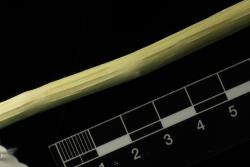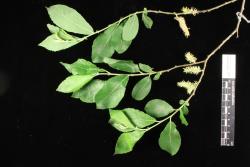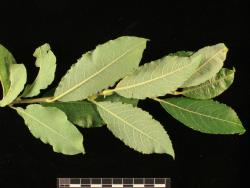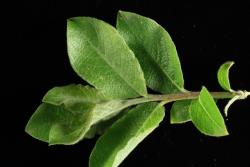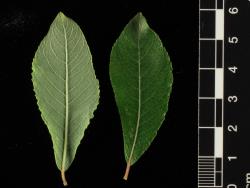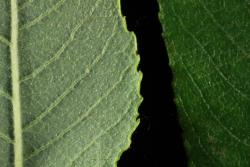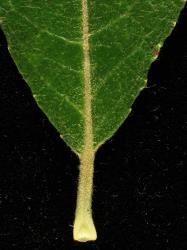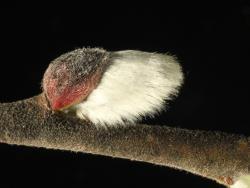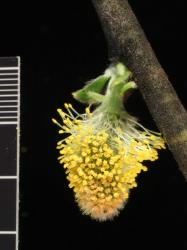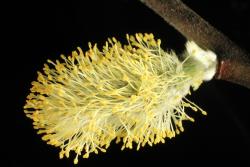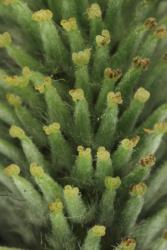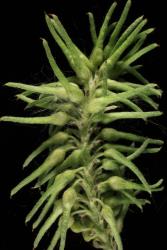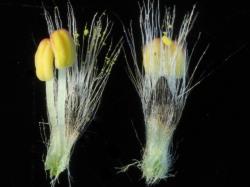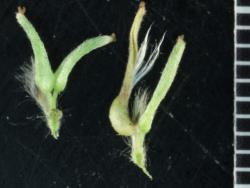Plant a multi-stemmed erect shrub to 12 m, bark grey, smooth, branchlet wood with ridges 5–9 mm long, sparse. Current year's branchlets light greyish brown (UCL60), densely tomentose. Year-old branchlets light to moderate olive (UCL106–107), glabrous, (1.9)2.1–3.2(3.5) mm diameter, mean diameter 2.8 mm. Flower bud scales 9–10 mm long, 5–6 mm wide, 4–5 mm deep, with 2 angles, dark red (UCL16), tomentose before opening, hairs rapidly rubbing off. Leaves alternate. Stipule persistent, 4–11 mm long, 3 mm wide, asymmetrically ovate, with obvious teeth and an acute apex. Petiole 4–13 mm long, densely tomentose, adaxial groove absent, glands absent, base of petiole pinky red to dirty brown. Emerging leaves green, rarely slightly tinged with orange, with dense silvery tomentum. Proximal leaves entire. Leaf lamina 62–110 mm long, 22–46 mm wide, length to width ratio 1.8–2.9:1, obovate or elliptical; base cuneate, rounded or truncate; apex acute to rounded; leaf galls absent; orange rust absent to sparse in late summer; margins distantly serrulate, finely revolute, undulate; upper lamina surface slightly bullate due to impressed veins, slightly glossy, glabrous except midvein, which remains tomentose, stomata absent; lower lamina surface midveins and side-veins raised, distinctly glaucous, moderately densely to sparsely tomentose. Catkins precocious. Flowering branch 28–44 mm long, with 4–5 cataphylls below catkin. Male catkin 18–35 mm long, 8–20 mm diameter; catkin rachis not visible between flowers. Female catkin 30–55 mm long, 9–29 mm diameter; catkin rachis visible or not between flowers. Flower bract 1.5–2.8 mm long, 0.5–1.1 mm wide, briefly crimson on emergence of catkin then distal half dark brown to black, proximal half hyaline, flat; apex acute, densely long-silky on both surfaces and margins, female bract persisting. Male nectary 1, 0.4–0.8 mm long, 0.2–0.4 mm wide, green turning yellow. Stamens 2, filaments free, hairs absent or present at the base of filament; anthers 0.8–1.4 mm long, yellow and slightly tinted orange before dehiscing. Female nectary 1, 0.5–0.7 mm long, 0.4–0.5 mm wide, yellow, sometimes 2-lobed; ovary 5.0–10.5 mm long, densely short-silky hairy; stipe 0.8–1.6 mm long; base of style 0.2–0.4 mm long, style arms 0.5–0.6 mm long, unlobed, yellow-green.
Observation of the wood ridges is essential for certain identification. Ridges are 5–9 mm long and sparse, similar to the wood ridges of Salix caprea. The ridges are much shorter and less dense than the wood of Salix cinerea (6–62 mm long, averaging 13–22 mm long) and S. atrocinerea ((8)12–30(33) mm long, averaging 16 mm long). Branchlet diameter is (1.9)2.1–3.5 mm, averaging 2.8 mm diameter. This is similar to the branchlet diameter of S. atrocinerea (average diameter 2.7 mm), but slenderer than that of S. cinerea (average diameter 3.1 mm). The upper leaf surface of the hybrid is finely but only weakly bullate, and this may be more apparent in the youngest leaves. Leaf margins are weakly toothed but some teeth are present, and teeth may be present on some part of the margin but entire elsewhere. The leaf may be undulate at the margins. Leaf hairs are silvery, never brown, and are moderately dense on young leaves, but on mature leaves are almost absent from the upper leaf surface, and sparse on the lower leaf surface.
Not easily distinguished from S. caprea, which can have similar sparse, short, wood ridges. Both are moderately densely tomentose on the lower leaf surface and sparsely hairy to glabrous on the upper surface of mature leaves. Neither is strongly glaucous on the lower surface, and both have raised netted veins below and impressed veins above. Catkins of both have bicoloured flower bracts that are densely hairy, and anthers of both are yellow. Leaves are elliptical and length to width ratio is similar (1.6–2.1:1 in S. caprea versus 1.8–2.9:1 in S. ×reichardtii). However, the leaves of S. ×reichardtii are narrower (22–46 mm wide) than those of S. caprea (53–61(70) mm wide). Brown hairs are usually present on the upper leaf surface of S. caprea; these are absent from leaves of S. ×reichardtii.
Auckland (Bethells Beach 1977, Manukau Harbour 2015), Southern North Island (Ōrongorongo River 1980), Canterbury (Christchurch and environs 1963–2019, Springston 1963, Little River 2021, Rakaia Gorge 1994, Rangitata River 1963, Totara Valley 1964), Otago (Milton 1957), Southland (Invercargill 1969, Bluff 1969). Herbarium records underestimate the frequency of this hybrid in the wild, and many specimens are difficult to identify because the branchlet wood has not been collected.
First collection: CHR 122324, A. J. Healy 57/521, 28 January 1957, Milton, Otago, "waste land, scattered trees on roadside and waste areas."
First publication: Kraayenoord & Hathaway (1986).
Flowering: Early August–late September.
Unknown but flow cytometry using PN714 provisionally indicates this hybrid is tetraploid (2n = 76).



